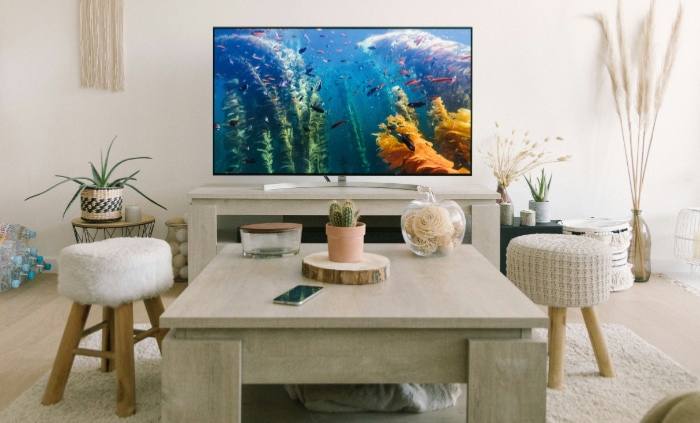OLED vs. QNED: Redefining Screen Standards

Advances in display technology have revolutionized the way we experience visual content, from the depth of the movies we watch to the clarity of the games we play. Two frontrunners in this dynamic field, OLED (Organic Light Emitting Diodes) and QNED (Quantum Nano Emitting Diodes), stand out for their groundbreaking approaches to enhancing our viewing pleasure.
Understanding OLED Technology
OLED, or Organic Light Emitting Diodes, represents a significant leap forward in display technology. This innovation allows screens to deliver stunning visuals characterized by deep blacks and vibrant colors.
Unlike traditional displays that require backlighting, OLED screens are made of organic materials that emit light when an electric current passes through them. This unique property enables each pixel to be controlled individually, leading to unparalleled picture quality and energy efficiency.
How OLED Works
At the heart of OLED technology lies a simple yet effective mechanism. When electricity is applied, the organic material within each diode emits light.
This direct light emission allows for precise control over brightness and color at the pixel level. As a result, OLED displays can achieve true black by turning off individual pixels, a feat impossible for LCD screens that rely on backlighting.
Advantages of OLED
Superior Color Accuracy and Contrast Ratios
OLED displays are renowned for their exceptional color accuracy and contrast ratios. Since each pixel emits its own light, the contrast between the darkest and brightest parts of the image is dramatically enhanced.
This leads to images that are rich, detailed, and full of depth.
Better Viewing Angles
OLED technology also offers superior viewing angles compared to traditional displays. Colors remain consistent and vibrant, even when viewed from sharp angles.
This means that the quality of the image stays intact no matter where you’re seated in relation to the screen.
Thinner and More Flexible Screens
Thanks to the self-emissive nature of OLED pixels, there’s no need for bulky backlighting systems. This allows for thinner display panels that can even be made flexible or curved, opening up new design possibilities for electronics manufacturers.
Limitations of OLED
Susceptibility to Burn-in
One of the few drawbacks of OLED technology is its susceptibility to burn-in. This occurs when a static image is displayed for an extended period, leading to the retention of faint outlines even after the image changes.
However, with careful use and advanced features designed to minimize this effect, burn-in can be effectively managed.
Higher Cost
The sophisticated manufacturing process of OLED displays often results in a higher price tag compared to LED/LCD screens. However, for many, the investment is justified by the superior visual experience and energy efficiency OLED technology offers.
Exploring QNED Technology
QNED, or Quantum Nano Emitting Diode technology, is an innovative approach to display screens that seeks to bridge the gap between OLED’s premium qualities and the practical advantages of LCDs. This technology combines Quantum Dots with NanoCell technology, enhanced by a mini LED backlight, to create images that are both bright and accurate in color.
QNED aims to deliver a high-quality viewing experience that competes with OLED, particularly in brightness and longevity, while potentially offering a more accessible price point for consumers.
How QNED Works
QNED utilizes a layered approach to enhance image quality. At its foundation, a mini LED backlight provides illumination.
This light then passes through a layer of Quantum Dots and NanoCells, which fine-tune the light for improved color accuracy and saturation. The Quantum Dots enhance the brightness and color spectrum, while NanoCells filter unwanted wavelengths to purify the colors further.
This combination allows QNED displays to produce vibrant visuals with impressive contrast and detail.
Advantages of QNED
Improved Brightness and Color Volume
One of the standout features of QNED technology is its ability to achieve high levels of brightness without sacrificing color quality. This makes QNED displays particularly suitable for brightly lit environments where glare might detract from the viewing experience.
Reduced Risk of Burn-in
Unlike OLED screens, QNED displays are less prone to burn-in due to their use of mini LED backlighting rather than self-emissive pixels. This characteristic makes QNED a robust choice for users who plan to use their screens for extended periods, especially with static images like user interfaces or news tickers.
Cost Efficiency
For large screen sizes, QNED technology potentially offers a more cost-effective solution compared to OLED. The manufacturing process for QNED screens, while complex, doesn’t involve the same costly organic materials required for OLED production, possibly leading to lower prices for consumers.
Limitations of QNED
Thicker Panels
Due to the layered structure required for the mini LED backlight and Quantum Dot/NanoCell technology, QNED displays tend to be thicker than their OLED counterparts. This may influence mounting and placement options for consumers prioritizing sleek, minimalist setups.
Viewing Angles
While QNED technology offers improved viewing angles over traditional LCDs, it may still fall short of the nearly universal viewing angles achieved by OLED screens. Colors and contrast can shift when viewed from extreme angles, which might be a consideration for rooms with wide seating arrangements.
Picture Quality and Performance

When choosing between OLED and QNED displays, understanding the nuances of picture quality and performance is crucial.
Black Levels and Contrast Ratio
OLED technology excels in producing true black levels. Since each pixel emits its own light, turning off individual pixels results in absolute blackness.
This capability ensures an exceptional contrast ratio, making the images on OLED screens appear more lifelike, with depth and dimension that is hard to match.
QNED, while not able to achieve the absolute black levels of OLED due to its reliance on backlighting, still offers impressive contrast ratios. The use of mini LED technology allows for finer control of dimming zones, which improves the display’s ability to manage dark scenes better than traditional LED/LCD screens, though with a slight compromise when compared to OLED.
Color Accuracy and Saturation
OLED screens are known for their wide color gamut and excellent color accuracy. The self-emissive nature of OLED pixels contributes to vibrant colors that are true to life, with rich saturation and nuanced shades that cater to the demands of high-quality content viewing.
QNED technology also boasts commendable color accuracy and saturation, thanks to the integration of Quantum Dots. These Quantum Dots enhance the brightness and purity of colors, allowing QNED displays to produce vivid and dynamic visuals.
However, OLED may still have a slight edge in rendering the deepest and most accurate colors.
Brightness and HDR Performance
While OLED displays offer stunning contrast and color accuracy, they typically do not reach the same brightness levels as some LED-based screens. This characteristic can affect HDR (High Dynamic Range) content, which relies on high brightness to enhance details in both dark and light areas of the picture.
QNED screens shine in the brightness and HDR performance arena. The combination of Quantum Dot technology and mini LED backlighting enables these displays to achieve high levels of brightness, making them ideal for viewing HDR content.
This increased brightness helps in bringing out finer details and enhancing the overall viewing experience, especially in well-lit environments.
Cost Considerations
When it comes to selecting a new display technology for your home or office, the price is often a decisive factor. Both OLED and QNED come with their own set of features that justify their cost, but understanding these can help you make a more informed decision that aligns with your budget and preferences.
Initial Purchase Price
OLED technology is generally associated with a higher initial cost. This is due to the complex manufacturing process and the use of organic materials, which are more expensive to produce.
However, the price of OLED TVs has been gradually decreasing as the technology matures and production efficiencies improve. Despite this, OLED remains at the premium end of the market, particularly for larger screen sizes.
QNED, being a newer technology that combines Quantum Dot and NanoCell technologies with mini LED backlighting, also comes with a relatively high price tag. However, the cost of QNED displays is often lower than OLED when comparing models of similar sizes and features.
This price difference makes QNED an attractive option for those seeking advanced display technology without the premium price of OLED.
Long-Term Savings
OLED screens are highly energy efficient due to their ability to turn off pixels completely, which reduces power consumption, especially in scenes with lots of black. Over time, this can lead to savings on your electricity bill, mitigating some of the initial investment in an OLED display.
QNED displays, while not as energy-efficient as OLEDs, still offer improvements over traditional LED/LCD screens. The precise control over lighting provided by mini LED technology allows for more efficient use of power, contributing to lower energy costs compared to older display technologies.
Factors Influencing Cost
Several factors can influence the cost of OLED and QNED displays, beyond the technology itself. These include:
- Screen Size: Larger screens are more expensive to manufacture and thus carry higher price tags.
- Brand and Model: Prices can vary significantly between different brands and even among different models within the same brand, based on the features and technology offered.
- Additional Features: Smart TV capabilities, high refresh rates, and other advanced features can also contribute to the overall cost.
Conclusion
Deciding between OLED and QNED technologies for your next display involves weighing various factors, including picture quality, performance, and cost. OLED stands out for its exceptional contrast ratios and color accuracy, making it ideal for viewers seeking cinematic immersion and detailed visuals.
On the other hand, QNED offers a compelling alternative with its impressive brightness and vibrant colors, suited for environments with high ambient light. While OLED might carry a higher price tag, its energy efficiency and unique ability to produce true blacks offer long-term value.
Conversely, QNED presents a cost-effective solution with its own set of advantages, including reduced risk of burn-in and potentially lower initial investment. Ultimately, your choice should align with your viewing preferences, environment, and budget, ensuring a satisfying visual experience that meets your needs.
Through careful consideration of these technologies’ distinct benefits and limitations, you can select a display that enhances your visual enjoyment for years to come.


